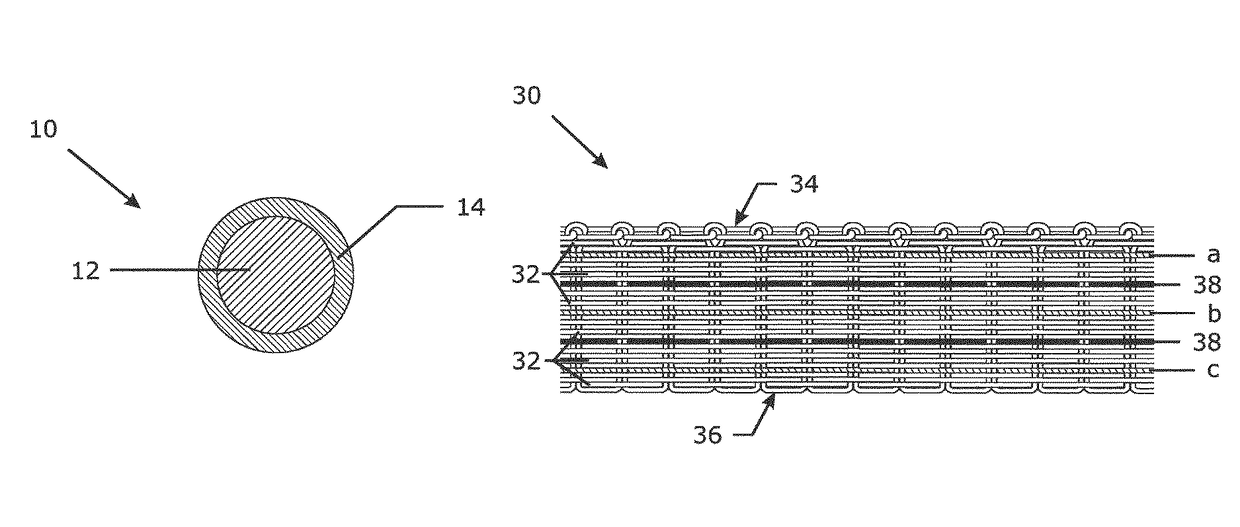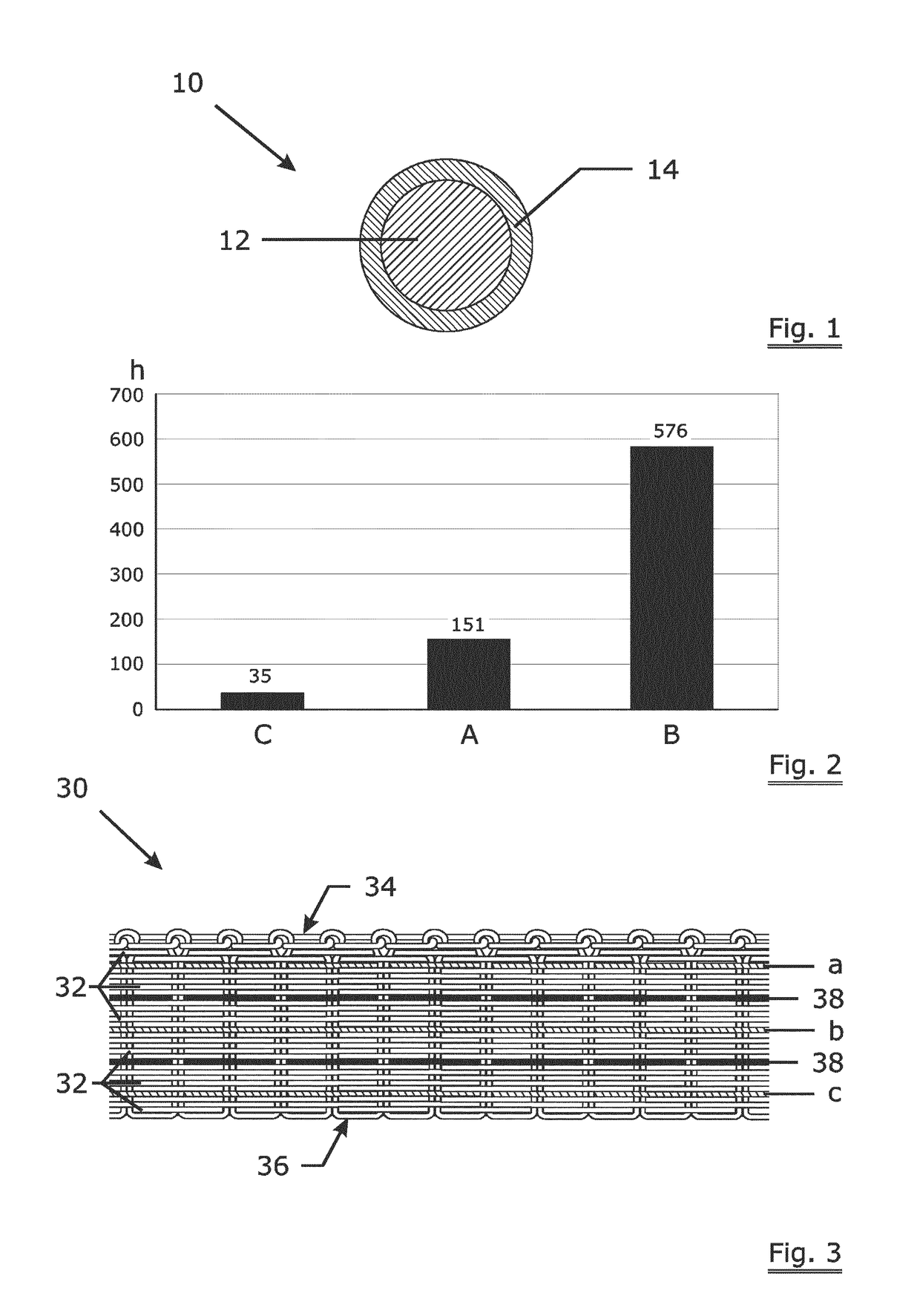[0009]It is a further object of this invention to provide electric fencing lines having prolonged life time and low cost.
[0011]The low carbon steel wire has a higher electrical conductivity than the stainless steel wires with a same diameter. The carbon steel wire according to the present invention has carbon content below 0.20 wt %, preferably below 0.05 wt % and more preferably below 0.03 wt %. The application of the low carbon steel wire in an electric fencing line can serve as a tension member on the one hand, and on the other hand it can provide considerable electric conductivity to the fencing line, therefore the application of conductive wires like copper wires can be omitted or at least the deployment of copper wires can be reduced.
[0012]According to the present invention, the carbon steel wire is coated with zinc aluminium alloy or zinc aluminium magnesium alloy. Zinc aluminium alloy or zinc aluminium magnesium alloy coating provides much better corrosion resistant to steel wire than traditional zinc coating. Importantly, zinc aluminium alloy or zinc aluminium magnesium alloy coating can be conventionally applied by hot dipping or electro-plating. The thicker the coating is, the longer time the carbon steel wire is protected, provided that the coating is homogeneously coated and stayed on the carbon steel wire. Also, heavily coated carbon steel wire can provide better conductivity which is beneficial as a conductive wire for electrical fencing lines. As disclosed in GB2321762, an unalloyed carbon steel wire cladded with copper layer, which should be rather thick, can provide sufficient electrical conductivity an electrically conducting fence. Copper is good in electrical conductivity but is not a good corrosion resistant material. In contrast herewith, zinc aluminium alloy or zinc aluminium magnesium alloy is a good corrosion resistant material and the coating can prevent the carbon steel wire from corrosion and provides electrical conductivity. Moreover, the coating weight of the zinc aluminium alloy or zinc aluminium magnesium alloy coating according to the present invention is in the range of 30 to 100 g / m2. Preferably, the coating weight is in the range of 40 to 60 g / m2. The thicker coating can provide better corrosion resistance but it would increase the cost of the coated wire. It is found that it is prone to create cracks in the thick coating since it is not able to follow the deformation of the carbon steel wire, e.g. due to the bending of the electric fencing lines. If the thick coating cracks or is locally damaged, corrosion would occur and the wire will be failed with a short life time. On the other hand, it has been found that sun shine is detrimental to the plastic material like polyethylene and an expected life time for plastic based electric fencing line is normally five years. The relatively thin zinc aluminium alloy or zinc aluminium magnesium alloy coating according to the invention is sufficient to prevent the carbon steel wire from corrosion in the industrial application environment for at least five years. Therefore, the zinc aluminium alloy or zinc aluminium magnesium alloy coating with a coating weight in the range of 30 to 100 g / m2 is optimised to provide conductivity and sufficient corrosion resistant to the electrically conducting wires during the life time of the electric fencing lines and at a low cost. In addition, the coated carbon steel wire is much cheaper than the stainless steel wires and copper wires which are commonly used for electric fencing lines.
[0013]According to the invention, the aluminium content of said zinc aluminium alloy coating is in the range of 3 to 20 wt %. This composition guarantees good corrosion resistance and adherence to the carbon steel wire. Preferably, the aluminium content of said zinc aluminium alloy coating is 5 wt %. More preferably, the aluminium content of said zinc aluminium alloy or zinc aluminium magnesium alloy coating is 10 wt % since this provides better corrosion protection and electrical conductivity. The magnesium content of said zinc aluminium magnesium alloy coating is in the range of 0.1 to 5 wt %, preferably in the range of 0.1 to 1 wt %, e.g. 0.3 wt % or 0.5 wt %. According to the invention, the aluminium content of said zinc aluminium magnesium alloy coating is in the range of 3 to 8 wt %. The magnesium content of said zinc aluminium magnesium alloy coating is in the range of 0.1 to 5 wt %, preferably in the range of 0.1 to 1 wt %, e.g. 0.3 wt % or 0.5 wt %.
[0015]The carbon steel wire used for electric fencing lines according to the invention has a diameter in the range of 0.1 to 1.0 mm, e.g. in the range of 0.2 to 0.3 mm. Preferably, the carbon steel wire coated with zinc aluminium alloy or zinc aluminium magnesium alloy is a redrawn wire. The redrawing of zinc aluminium alloy or zinc aluminium magnesium alloy coated wire can improve the tensile strength of the coated carbon steel wire and enhance the adhesion between the zinc aluminium alloy (or zinc aluminium magnesium alloy) coating and carbon steel wire. The coated carbon steel wire according to the invention has a tensile strength in the range of 900 to 1250 N / mm2. The specific electrical resistance in the range of 4×10−8 to 5.0×10−7 Ω·m (i.e. specific electrical resistance in the range of 2×106 to 2.5×107 S / m), preferably 8×10−8 to 2.5×10−7 Ω·m (i.e. specific electrical resistance in the range of 4×106 to 1.25×107 S / m).
[0016]According to the second aspect of the present invention, it is provided an electric fencing line comprising one or more carbon steel wires as described above incorporated in a plastic material. The electric fencing line is in a form of a tape, a rope, a strand or a plaited braid. The electrical fencing lines may have the configuration as illustrated in U.S. Pat. No. 5,036,166 or GB2321762, while the stainless steel wires thereof or both the stainless steel wires and the copper wires thereof are replaced by the coated carbon steel wire according to the present invention. Specifically, the electric fencing line is an electric fencing tape made by plaiting, knitting or weaving one or more the coated carbon steel wire according to the present invention into non-conducting plastic filaments. The non-conducting plastic filaments may be plurality of warp filaments and weft filaments made of polyethylene, polyamide, polyester, polypropylene or other plastic materials. In addition, the electric fencing line may further comprise one or more copper wires being incorporated in the plastic material. The application of copper wires together with the coated carbon steel wires may increase the conductivity of the electric fencing lines.
 Login to View More
Login to View More 

